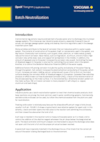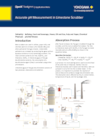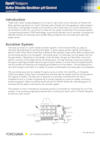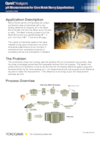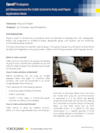On-line measurements often present extra challenges, especially when routine maintenance is required. The PR10 is ideal for applications where the sensors must be removed without interrupting or shutting down the process. Without any special tools, the PR10 can be retracted safely from the process at pressures up to 5 bar (72 psi). The PR10 is a universal retractable assembly that can be used for all liquid measurements. The PR10 is designed to accept any commercially available pH/ORP or dissolved oxygen sensor that has a PG13.5 connection while still being backwards compatible with old Yokogawa electrodes.
For ease of use, optional flush ports are available. In the retracted position, the sensor can be kept moist, cleaned, or even calibrated. This can all be done without process interruption or disassembly of the armature.
What Are the Benefits of the PR10 Retractable Assembly?
- One model for pH/ORP, dissolved oxygen, conductivity, and inductive conductivity sensors
- All commercially available pH electrodes, such as PG13.5, SMART sensors, Vario Pin, YEF, and DIN connectors can be installed in the PR10
- Integrated protection cage
- "Scrapers" are built-in to each assembly to effectively scrape/wipe the process from the PR10's shaft as it is retracted from the process
- A safe "through the valve" insertion and retraction design
- Simplified installation by optional ball valves with flanged or tapered connections
- Optional flush port accessories makes it easy to keep sensors moist (pH) and clean, and also provides access for calibration if desired
Refer to >> Process Liquid Analyzer Sensor Wiring Guide
Resources
For control of batch neutralization, a pH measurement coupled with a timer-controlled chemical feed scheme provides very satisfactory results.
This system can be adapted for either acid waste or alkaline waste neutralization.
Wet scrubbers are used in utilities, paper mills, and chemical plants to remove sulfur dioxide (SO2) and other pollutants from gas streams. Undesirable pollutants are removed by contacting the gases with an aqueous solution or slurry containing a sorbent. The most common sorbents are lime, Ca(OH)2, and limestone, CaCO3.
Process liquid analyzers such as pH meters, conductivity meters, ORP meters, and density meters play an important role at electrolysis plants in the control of concentrations of various process solutions. This requires both precision and stability under harsh conditions that include highly corrosive substances, high temperatures, and many impurities.
Conductivity measurement can be used as a reliable indicator of the real-time brine concentration. Using an online process analyzer removes the need for timely grab sample analysis.
Power plant boiler houses designed to burn coal or high sulfur oil are required by Federal and State pollution regulations to "scrub" (remove) sulfur dioxide from flue gasses to meet emission limits. SO2 in flue gasses is known to be harmful to the environment, as it is one contributor to the formation of acid rain. pH control is critical for the proper functioning of the scrubber system.
The quality of paper for printing or writing should be high and it depends on many parameters. Cobb is one of the parameters, which requires control. Using a retractable fitting, this optimum pH level can be achieved by using Yokogawa's 4-wire pH Analyzer with a suitable, retractable fitting and sensor. Since a separate controller is not required for the dosing pump, this solution provides a cost-saving.
Current trend for increasing mercury awareness throughout the public sector has caused the government to take action. Recently, the Environmental Protection Agency (EPA) has focused their efforts on controlling mercury levels produced in various coal fired power plants. Based on information from several case studies, the EPA developed the Mercury and Air Toxics Standards to cut back mercury emissions. The most popular technology utilized by coal plants to meet the new standards is a scrubber which cleans the off gas from the combustion process. ORP sensors can further monitor the effluent from these scrubbers to ensure optimal mercury emission levels are achieved. By closely monitoring the mercury concentrations in the effluent, plant managers will be able to easily confirm their plants are meeting the EPA's standards.
Downloads
Instruction Manuals
General Specifications
Technical Information
- A Word About Buffers
- Process Liquid Analyzer Sensor Wiring Guide
- Care & Maintenance in High Purity Water (85 KB)
- FLEXA/EXA PH Series Process pH Analyzers Measurement System and Applications (2.4 MB)
- PR10 Maintenance Guide (261 KB)
- PR10 Quick Start Installation Guide (1.4 MB)
- PR10 Quick Start pH Guide (823 KB)
- Temperature Compensation (115 KB)
- Wet vs Dry Electrodes, Problems and Solutions (111 KB)
Certificates
- Mercury Free Declaration (101 KB)
- PR10 CE (329 KB)
- EU_UK Declaration of Conformity PR10 2022-10-03 (149 KB)
Engineering Tools
- pH/ORP and DO Versions (132 KB)
- SC Versions (130 KB)
Videos
This video covers a PR10 installation and extraction. While we strive to provide the most safe and accurate information possible, we are not responsible for any loss or damages resulting from attempting to replicate the acts conducted in this video. Furthermore, we shall not be held liable for use or misuse of information contained in this video.
Looking for more information on our people, technology and solutions?
Contact Us
